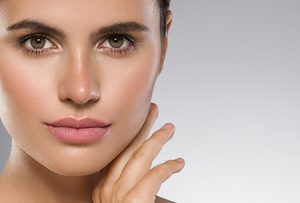
What is Rhinoplasty?
Rhinoplasty is a surgical procedure that changes the shape and size of the nose. Also known as a nose job, rhinoplasty can be used to improve breathing or enhance the appearance and symmetry of the nose and face.

If you are considering nose surgery in Sacramento, the Plastic Surgery Center is here to help. Our talented cosmetic surgeons have over 100 combined years of experience providing plastic and reconstructive surgery to patients in need. Our doctors and staff are highly trained and have provided countless rhinoplasty patients with outstanding results and renewed confidence. Visit our rhinoplasty before and after photo gallery to view results from our previous patients.
How Nose Surgery Is Performed
Rhinoplasty is performed under local anesthesia with either intravenous sedation or general anesthesia. Facial rejuvenation is achieved through incisions that are made to allow your surgeon access to the bone and cartilage that will be sculpted. Depending upon the extent of the procedure, nasal surgery can take from 1 to 2 hours. Prior to any cosmetic surgery procedure, be sure to follow your plastic surgeon’s instructions on taking medications and vitamins, eating, drinking and stopping smoking.
Advanced Rhinoplasty Techniques
Advancements in rhinoplasty are continually improving the precision and outcomes of nose surgery. Two notable techniques that have revolutionized the field are ultrasonic rhinoplasty and piezoelectric rhinoplasty.
Ultrasonic Rhinoplasty: This technique utilizes ultrasonic energy to reshape the nasal bones with high precision. Unlike traditional methods that require more forceful manipulation, ultrasonic tools allow surgeons to delicately sculpt the nasal framework, reducing the risk of trauma to surrounding tissues. This results in less bruising and swelling during recovery, offering patients a smoother postoperative experience.
Piezoelectric Rhinoplasty: Similar to ultrasonic rhinoplasty, this method uses piezoelectric instruments that vibrate at ultrasonic frequencies. These instruments are so precise that they can cut hard tissues without damaging soft tissues. This technique is particularly beneficial for delicate bone reshaping, making it ideal for detailed refinements and adjustments in nasal contouring.
Rhinoplasty Myths and Facts
 Myth #1: Rhinoplasty is purely cosmetic and has no other benefits.
Myth #1: Rhinoplasty is purely cosmetic and has no other benefits.
Fact #1: While rhinoplasty can significantly improve the appearance of the nose, it also has functional benefits, such as improving breathing and correcting structural abnormalities.
Myth #2: The results of rhinoplasty are immediately visible.
Fact #2: Swelling and changes in nasal tissues mean the final results of a rhinoplasty may take up to a year to be fully apparent.
Myth #3: Rhinoplasty is a painful procedure with a long recovery.
Fact #3: Modern surgical techniques have minimized pain and reduced recovery times significantly. Most patients report only mild discomfort.
Choosing the Right Rhinoplasty Surgeon
Rhinoplasty is considered one of the most complex forms of plastic surgery among plastic surgeons. Therefore, selecting the right surgeon for your rhinoplasty is crucial to achieving the best results. Consider the following when making your choice:
- Board Certification: Ensure that the surgeon is certified by the American Board of Plastic Surgery. This certification indicates that the surgeon has undergone rigorous training and adheres to high standards of practice.
- Experience and Specialization: Look for a surgeon who specializes in facial procedures and has extensive experience in rhinoplasty. Reviewing before-and-after photos of previous surgeries can help assess their skill level.
- Patient Reviews and Testimonials: Reading reviews and talking to former patients can provide insights into the surgeon’s approach and the satisfaction level of their clients.
- Consultation Process: A thorough consultation should include a detailed discussion of your goals, an assessment of your nasal structure, and a realistic presentation of potential outcomes. This is your opportunity to develop a relationship with a surgeon.
What To Expect After Your Rhinoplasty
Tape, a splint and gauze will be applied immediately following your plastic surgery to stabilize your nose. During the first 24 hours, it is natural for your face to feel puffy. Your nose might be painful and you might have a dull headache; medication can minimize any discomfort. Black eyes are to be expected, so plan to stay in bed with your head elevated the first day. Any swelling or bruising can be reduced with a cold compress. Most patients return to their normal routines within about a week, although your nose may remain somewhat swollen and sensitive for the first few weeks. During this time, it is recommended that you avoid strenuous activities that can either risk injuring your nose or raising your blood pressure. Desired results might not be seen until 6 to 12 months.
Rhinoplasty Results
 The results of rhinoplasty are long-lasting and often life changing. After the initial healing period, the changes in the shape and structure of your nose will stabilize and can last a lifetime. To maintain your results long term, our surgeons recommend:
The results of rhinoplasty are long-lasting and often life changing. After the initial healing period, the changes in the shape and structure of your nose will stabilize and can last a lifetime. To maintain your results long term, our surgeons recommend:
- Protection from the Sun: Prolonged sun exposure can cause damage and discoloration to the sensitive skin on your nose post-surgery. Always apply a high-SPF sunscreen and wear hats when out in direct sunlight.
- Healthy Lifestyle: Maintaining a stable weight and adopting a healthy lifestyle helps prevent changes in skin quality and fat distribution, which can affect your results.
- Avoid Trauma: Protect your nose from potential injuries, especially in the months following your surgery, as it is crucial for maintaining the new shape of your nose.
- Check-Ups: Schedule follow-up appointments with your surgeon to ensure that your nose maintains its desired shape and to address any concerns promptly.
Rhinoplasty Revision: Refining Your Results
Even with a skilled surgeon, about 10-15% of rhinoplasty patients seek a revision. This could be due to several factors, including healing complications, structural issues, or aesthetic dissatisfaction. Rhinoplasty revision is a more complex procedure due to the changes in anatomy and scar tissue from the initial surgery. It requires a highly skilled plastic surgeon with expertise in revision procedures to effectively address and correct specific concerns while minimizing additional scarring.
Complementary Procedures to Enhance Rhinoplasty
To achieve optimal facial harmony, rhinoplasty is often combined with other facial procedures. Common complementary procedures include:
- Chin Augmentation: Enhancing the chin can provide a better balance between facial features, especially if the rhinoplasty alters the perceived size of the nose.
- Lip Augmentation: This can balance the proportions of the face after a nose reshaping, particularly if the lips appear smaller post-operation.
- Facial Fat Grafting: Adding volume to other areas of the face can help achieve a more balanced and youthful appearance.
Together, these procedures can enhance the overall aesthetic result, leading to not just a new nose, but a beautifully rejuvenated face.
Call (916) 848-5780 now to learn more about medical spa services, facial rejuvenation and cosmetic surgery procedures for both men and women, such as rhinoplasty. Sacramento plastic surgeons at The Skin Care Center and at The Plastic Surgery Center make enhancing the body, mind and spirit easy. With offices on Scripps Drive in Sacramento and in Granite Bay, looking and feeling your best is convenient as well.
Rhinoplasty FAQs
What are some of the reasons patients choose rhinoplasty?
Although injuries and medical conditions are often reasons why patients undergo rhinoplasty, aesthetic concerns are what have made the procedure one of the most requested plastic surgeries, here and around the world. Popular modifications include straightening the nose, changing its angle, reshaping the tip, narrowing the bridge, and altering the width of the nostrils.
Often the reason for a rhinoplasty is purely subjective: the size and shape of the nose may seem fine in isolation, but a patient may believe that it clashes with the lines, curves and angles of other facial features. Unwanted characteristics include a bulbous tip, a bump and a nose that is too wide. There are surgical solutions for each of these examples, and others. The board-certified surgeons of The Plastic Surgery Center are skilled in reducing the size or thinning a nose, adding volume, correcting imperfections, and changing the projection and angle of the nose.
Our experienced surgeons have also performed hundreds of procedures that address medical conditions, such as fixing a broken nose, widening nasal passages or removing obstructions for patients with breathing problems, and repairing a deviated septum, the wall that separates the breathing passages.
Are there differences between male and female rhinoplasty?
In general, men seek a more prominent nose, and women a smaller and more refined version. Some of this has to do with basic anatomy. Women’s features and bone structure provide the skeletal context for a petite nose. The prominent chins and more expansive facial dimensions of men make a longer, larger nose feel at home. Male noses tend to feature higher bridges, larger nostrils and thicker skin. Female noses typically have a delicate slope from the bridge and a slightly greater upward angle at the end.
These are characteristics that patients usually want to enhance, rather than reverse. For example, men may want to highlight straight, sleek lines, while female patients routinely prefer to accentuate naturally graceful arcs and inclines, along with a subtle upturn of the tip.
When it comes to the actual surgical procedure, these gender differences are mostly irrelevant. The thicker skin of the male nose slightly affects healing, but surgical techniques are the same for men and women.
How long will swelling last?
Depending on the complexity of your procedure, swelling can persist for a year, and sometimes longer. This is especially true of the tip of the nose. Fortunately, most swelling will subside within two months, and you should be ready to present your new facial profile to the world in about two weeks.
If you’ve had an open rhinoplasty, there will be more swelling and it will take longer to subside. Rhinoplasty that involves breaking nasal bones will also put more stress on the nose, resulting in greater swelling and an extended recovery.
If swelling continues to bother you after several months, your surgeon can administer a steroid injection at the site of maximum swelling. The persistence of swelling means that waiting for the ultimate result takes time, and requires patience. If your nose appears slightly asymmetrical during the first week of healing, it will almost certainly be well-proportioned and balanced at the end of the recovery process.
As your nose heals, it can be helpful to refer to computer imaging models your surgeon created for you during your initial consultations. These will be a more accurate predictor of your final result than the swollen nose you see in the mirror during the first weeks after surgery.
What Kind of Cultural Considerations Are Incorporated into Rhinoplasty?
 Rhinoplasty should enhance a patient’s natural beauty while respecting individual cultural aesthetics. It’s essential for surgeons to understand the diverse ideals of nasal shapes across different cultures to maintain an authentic look that aligns with the patient’s ethnic background and personal preferences. This approach ensures that results are not only beautiful but also culturally congruent, promoting a greater sense of identity and self-esteem. Because our surgeons treat a diverse population here in Sacramento, we have experience achieving appealing, natural-looking results for patients of all ethnic backgrounds.
Rhinoplasty should enhance a patient’s natural beauty while respecting individual cultural aesthetics. It’s essential for surgeons to understand the diverse ideals of nasal shapes across different cultures to maintain an authentic look that aligns with the patient’s ethnic background and personal preferences. This approach ensures that results are not only beautiful but also culturally congruent, promoting a greater sense of identity and self-esteem. Because our surgeons treat a diverse population here in Sacramento, we have experience achieving appealing, natural-looking results for patients of all ethnic backgrounds.
Do You Offer Non-Surgical Alternatives to Rhinoplasty?
For those hesitant about undergoing surgery or seeking less permanent solutions, non-surgical rhinoplasty might be an ideal alternative. This procedure involves the use of dermal fillers to temporarily alter the shape of the nose without incisions. While the results are not permanent — typically lasting from six months to two years — this technique can be used to smooth out bumps, lift the angle of the tip, or make the nose appear less angular.
How is Male Rhinoplasty Different from Rhinoplasty for Women?
 Rhinoplasty for men requires a different approach than the one used for procedures performed on women. Key differences include:
Rhinoplasty for men requires a different approach than the one used for procedures performed on women. Key differences include:
- Aesthetic Goals: Men typically prefer a more pronounced, angular nose that enhances masculine features, whereas women may seek a softer, more delicate nasal shape.
- Skin Thickness: Men often have thicker skin which can affect the process of shaping the nose and the visibility of underlying structures, requiring specific techniques to achieve desired contours.
- Structural Differences: The male nasal bone tends to be larger and requires adjustments in technique to achieve a natural, proportional result.
Learn More about Rhinoplasty in Sacramento
For top nose surgery results in Northern California, visit the experienced cosmetic surgeons at The Plastic Surgery Center. Our doctors will walk you through your surgery options and discuss the preparation and recovery for the procedure. Schedule a consultation today by calling (916) 848-5780 or by emailing us today.


 Our Reviews
Our Reviews